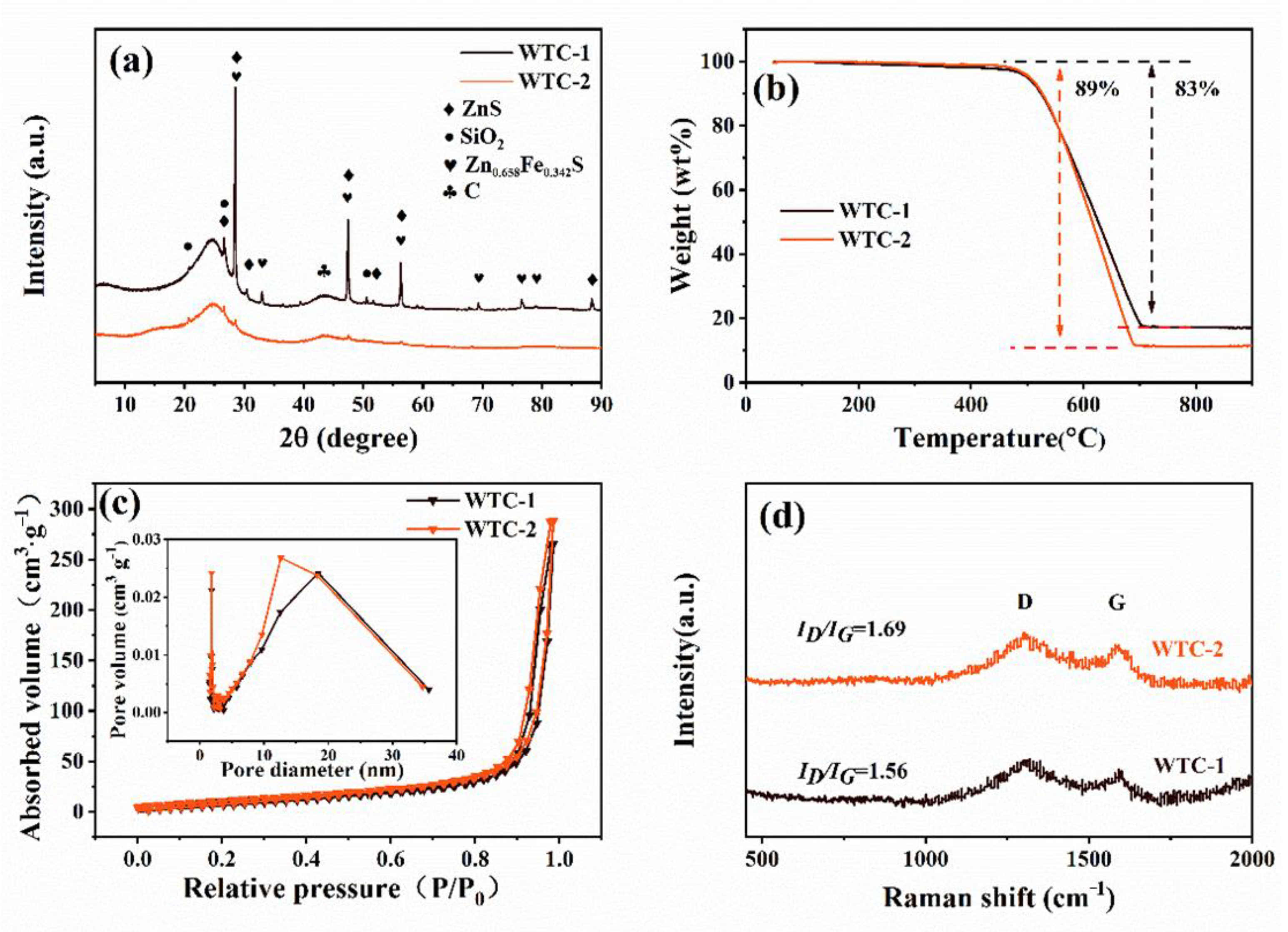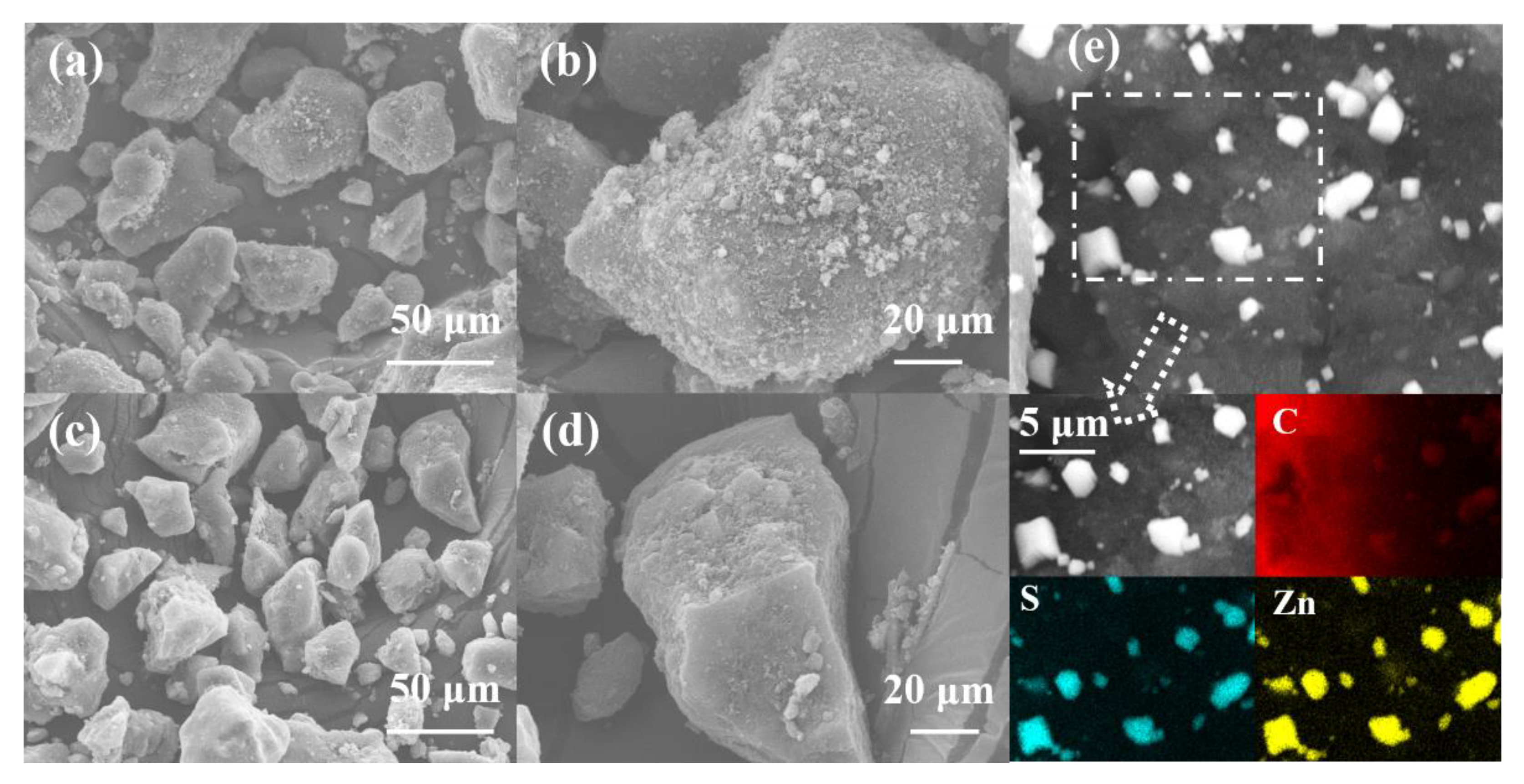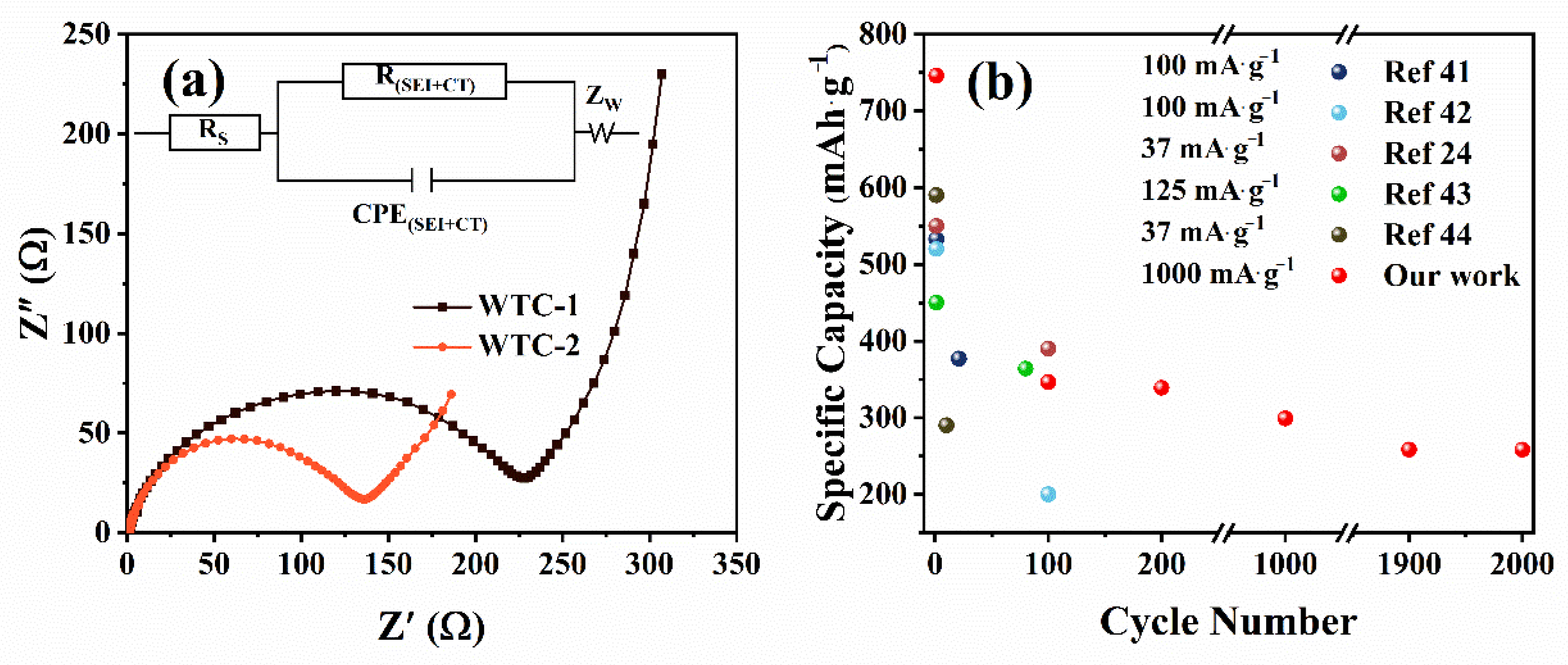The Positive Effect of ZnS in Waste Tire Carbon as Anode for Lithium-Ion Batteries
Abstract
:1. Introduction
2. Materials and Methods
2.1. Materials
2.2. Preparation
2.3. Characterization
2.4. Electrochemical Measurements
3. Results and Discussions
4. Conclusions
Supplementary Materials
Author Contributions
Funding
Institutional Review Board Statement
Informed Consent Statement
Data Availability Statement
Conflicts of Interest
References
- Abbaspour, M.; Aflaki, E.; Moghadas Nejad, F. Reuse of waste tire textile fibers as soil reinforcement. J. Clean. Prod. 2019, 207, 1059–1071. [Google Scholar] [CrossRef]
- Yadav, J.S.; Tiwari, S.K. The impact of end-of-life tires on the mechanical properties of fine-grained soil: A review. Environ. Dev. Sustain. 2019, 21, 485–568. [Google Scholar] [CrossRef]
- Wang, Q.; Wang, N.; Tseng, M.; Huang, Y.; Li, N. Waste tire recycling assessment: Road application potential and carbon emissions reduction analysis of crumb rubber modified asphalt in China. J. Clean. Prod. 2020, 249, 119411. [Google Scholar] [CrossRef]
- Chen, W.; Feng, H.; Shen, D.; Jia, Y.; Li, N.; Ying, X.; Chen, T.; Zhou, Y.; Guo, J.; Zhou, M. Carbon materials derived from waste tires as high-performance anodes in microbial fuel cells. Sci. Total Environ. 2017, 618, 804–809. [Google Scholar] [CrossRef] [PubMed]
- Shu, X.; Huang, B. Recycling of waste tire rubber in asphalt and portland cement concrete: An overview. Constr. Build. Mater. 2014, 67, 217–224. [Google Scholar] [CrossRef]
- Boota, M.; Paranthaman, M.P.; Naskar, A.K.; Li, Y.; Akato, K.; Gogotsi, Y. Waste tire derived carbon-polymer composite paper as pseudocapacitive electrode with long cycle life. ChemSusChem 2015, 8, 3576–3581. [Google Scholar] [CrossRef] [PubMed]
- Aranda, A.; Murillo, R.; García, T.; Mastral, A.M. Simulation and optimization of tyre-based steam activated carbons production for gas-phase polycyclic aromatic hydrocarbons abatement. Chem. Eng. J. 2004, 99, 123–132. [Google Scholar] [CrossRef]
- Selbes, M.; Yilmaz, O.; Khan, A.A.; Karanfil, T. Leaching of DOC, DN, and inorganic constituents from scrap tires. Chemosphere 2015, 139, 617–623. [Google Scholar] [CrossRef]
- Czajczyńska, D.; Krzyżyńska, R.; Jouhara, H.; Spencer, N. Use of pyrolytic gas from waste tire as a fuel: A review. Energy 2017, 134, 1121–1131. [Google Scholar] [CrossRef]
- Xu, J.; Yu, J.; Xu, J.; Sun, C.; He, W.; Huang, J.; Li, G. High-value utilization of waste tires: A review with focus on modified carbon black from pyrolysis. Sci. Total Environ. 2020, 742, 140235. [Google Scholar] [CrossRef]
- Li, W.; Huang, C.; Li, D.; Huo, P.; Wang, M.; Han, L.; Chen, G.; Li, H.; Li, X.; Wang, Y.; et al. Derived oil production by catalytic pyrolysis of scrap tires. Chin. J. Catal. 2016, 37, 526–532. [Google Scholar] [CrossRef]
- Zhang, Y.; Ji, G.; Li, C.; Wang, X.; Li, A. Templating synthesis of hierarchical porous carbon from heavy residue of tire pyrolysis oil for methylene blue removal. Chem. Eng. J. 2020, 390, 124398. [Google Scholar] [CrossRef]
- Zhang, Y.; Zhang, Z.; Wemyss, A.M.; Wan, C.; Liu, Y.; Song, P.; Wang, S. Effective thermal-oxidative reclamation of waste tire tubbers for producing high-performance rubber composites. ACS Sustain. Chem. Eng. 2020, 8, 9079–9087. [Google Scholar] [CrossRef]
- Li, Y.; Paranthaman, M.P.; Akato, K.; Naskar, A.K.; Levine, A.M.; Lee, R.J.; Kim, S.-O.; Zhang, J.; Dai, S.; Manthiram, A. Tire-derived carbon composite anodes for sodium-ion batteries. J. Power Sources 2016, 316, 232–238. [Google Scholar] [CrossRef] [Green Version]
- Jang, Y.S.; Kang, Y.C. Facile one-pot synthesis of spherical zinc sulfide–carbon nanocomposite powders with superior electrochemical properties as anode materials for Li-ion batteries. PCCP 2013, 15, 16437. [Google Scholar] [CrossRef] [PubMed]
- Sarno, M.; Baldino, L.; Scudieri, C.; Cardea, S.; Ciambelli, P.; Reverchon, E. SC-CO2 assisted process for high energy density aerogel supercapacitor: The effect of GO loading. Nanotechnology 2017, 28, 204001. [Google Scholar] [CrossRef]
- Zhang, L.; Zhang, B.; Wang, C.; Dou, Y.; Zhang, Q.; Liu, Y.; Gao, H.; Al-Mamun, M.; Pang, W.K.; Guo, Z. Constructing the best symmetric full K-ion battery with the NASICON-type K3V2(PO4)3. Nano Energy 2019, 60, 432–439. [Google Scholar] [CrossRef]
- Zhang, L.; Zhang, B.; Dou, Y.; Wang, Y.; Liu, H. Self-assembling hollow carbon nanobeads into double-shell microspheres as a hierarchical sulfur host for sustainable room-temperature sodium-sulfur batteries. ACS Appl. Mater. Interfaces 2018, 10, 432–439. [Google Scholar] [CrossRef] [Green Version]
- Ayanoğlu, A.; Yumrutaş, R. Production of gasoline and diesel like fuels from waste tire oil by using catalytic pyrolysis. Energy 2016, 103, 456–468. [Google Scholar] [CrossRef]
- Hu, H.; Fang, Y.; Liu, H.; Yu, R.; Luo, G.; Liu, W.; Li, A.; Yao, H. The fate of sulfur during rapid pyrolysis of scrap tires. Chemosphere 2014, 97, 102–107. [Google Scholar] [CrossRef]
- López, F.A.; Centeno, T.A.; Rodríguez, O.; Alguacil, F.J. Preparation and characterization of activated carbon from the char produced in the thermolysis of granulated scrap tyres. J. Air Waste Manag. Assoc. 2013, 63, 534–544. [Google Scholar] [CrossRef] [Green Version]
- Wang, M.; Zhang, L.; Li, A.; Irfan, M.; Du, Y.; Di, W. Comparative pyrolysis behaviors of tire tread and side wall from waste tire and characterization of the resulting chars. J. Environ. Manag. 2019, 232, 364–371. [Google Scholar] [CrossRef] [PubMed]
- Seng-Eiad, S.; Jitkarnka, S. Untreated and HNO3-treated pyrolysis char as catalysts for pyrolysis of waste tire: In-depth analysis of tire-derived products and char characterization. J. Anal. Appl. Pyrolysis 2016, 122, 151–159. [Google Scholar] [CrossRef]
- Naskar, A.K.; Bi, Z.; Li, Y.; Akato, S.K.; Saha, D.; Chi, M.; Bridges, C.A.; Paranthaman, M.P. Tailored recovery of carbons from waste tires for enhanced performance as anodes in lithium-ion batteries. RSC Adv. 2014, 4, 38213–38221. [Google Scholar] [CrossRef]
- Guan, P.; Li, J.; Lu, T.; Guan, T.; Ma, Z.; Peng, Z.; Zhu, X.; Zhang, L. Facile and scalable approach to fabricate granadilla-like porous structured silicon-based anode for lithium ion batteries. ACS Appl. Mater. Interfaces 2018, 10, 34283–34290. [Google Scholar] [CrossRef] [PubMed]
- Lin, H.Y.; Chen, W.C.; Yuan, C.S.; Hung, C.H. Surface functional characteristics (C, O, S) of waste tire-derived carbon black before and after steam activation. J. Air Waste Manag. Assoc. 2008, 58, 78–84. [Google Scholar] [CrossRef] [Green Version]
- Huang, L.; Zhang, Y.; Shang, C.; Wang, X.; Zhou, G.; Ou, J.; Wang, Y. ZnS nanotubes/carbon cloth as a reversible and high-capacity anode material for lithium-ion batteries. ChemElectroChem 2019, 6, 461–466. [Google Scholar] [CrossRef]
- Acevedo, B.; Barriocanal, C. Texture and surface chemistry of activated carbons obtained from tyre wastes. Fuel Process. Technol. 2015, 134, 275–283. [Google Scholar] [CrossRef] [Green Version]
- Pang, Q.; Tang, J.; Huang, H.; Liang, X.; Hart, C.; Tam, K.C.; Nazar, L.F. A nitrogen and sulfur dual-doped carbon derived from polyrhodanine@cellulose for advanced lithium-sulfur batteries. Adv. Mater. 2015, 27, 6021–6028. [Google Scholar] [CrossRef]
- Wang, J.; Liu, J.; Yang, H.; Chao, D.; Shen, Z. MoS2 nanosheets decorated Ni3S2@MoS2 coaxial nanofibers: Constructing an ideal heterostructure for enhanced Na-ion storage. Nano Energy 2016, 20, 1–10. [Google Scholar] [CrossRef]
- Liang, X.; Kwok, C.Y.; Lodi-Marzano, F.; Pang, Q.; Cuisinier, M.; Huang, H.; Hart, C.J.; Houtarde, D.; Kaup, K.; Sommer, H.; et al. Tuning transition metal oxide-sulfur interactions for long life lithium sulfur batteries: The “goldilocks” principle. Adv. Energy Mater. 2016, 6, 1501636. [Google Scholar] [CrossRef]
- Wen, X.; Yang, L.; Shen, P.K.; Wei, X. Self-assembled FeS2 cubes anchored on reduced graphene oxide as an anode material for lithium ion batteries. J. Mater. Chem. A 2015, 3, 2090–2096. [Google Scholar] [CrossRef]
- Tajoli, F.; Dengo, N.; Mognato, M.; Dolcet, P.; Lucchini, G.; Faresin, A.; Grunwaldt, J.; Huang, X.; Badocco, D.; Maggini, M.; et al. Microfluidic crystallization of surfactant-free doped zinc sulfide nanoparticles for optical bioimaging applications. ACS Appl. Mater. Interfaces 2020, 12, 44074–44087. [Google Scholar] [CrossRef]
- Chen, Z.; Wu, R.; Wang, H.; Jiang, Y.; Jin, L.; Guo, Y.; Song, Y.; Fang, F.; Sun, D. Construction of hybrid hollow architectures by in-situ rooting ultrafine ZnS nanorods within porous carbon polyhedra for enhanced lithium storage properties. Chem. Eng. J. 2017, 326, 680–690. [Google Scholar] [CrossRef]
- Guan, P.; Zhang, W.; Li, C.; Han, N.; Wang, X.; Li, Q.; Song, G.; Peng, Z.; Li, J.; Zhang, L.; et al. Low-cost urchin-like silicon-based anode with superior conductivity for lithium storage applications. J. Colloid Interface Sci. 2020, 575, 150–157. [Google Scholar] [CrossRef]
- Zhang, W.; Li, J.; Guan, P.; Lv, C.; Yang, C.; Han, N.; Wang, X.; Song, G.; Peng, Z. One-pot sol-gel synthesis of Si/C yolk-shell anodes for high performance lithium-ion batteries. J. Alloys Compd. 2020, 835, 155135. [Google Scholar] [CrossRef]
- Zhu, X.; Yang, X.; Lv, C.; Guo, S.; Li, J.; Zheng, Z.; Zhu, H.; Yang, D. New approach to create TiO2(B)/carbon core/shell nanotubes: Ideal structure for enhanced lithium ion storage. ACS Appl. Mater. Interfaces 2016, 8, 18815–18821. [Google Scholar] [CrossRef] [PubMed]
- Chen, R.C.; Hsiao, L.Y.; Wu, C.Y.; Duh, J.G. Facile synthesizing silicon waste/carbon composites via rapid thermal process for lithium-ion battery anode. J. Alloys Compd. 2019, 791, 19–29. [Google Scholar] [CrossRef]
- Du, X.; Zhao, H.; Lu, Y.; Zhang, Z.; Kulka, A.; Świerczek, K. Synthesis of core-shell-like ZnS/C nanocomposite as improved anode material for lithium ion batteries. Electrochim. Acta 2017, 228, 100–106. [Google Scholar] [CrossRef]
- Teng, Y.; Liu, H.; Liu, D.; He, H.; Chen, Y. Pitaya-like carbon-coated ZnS/carbon nanospheres with inner three-dimensional nanostructure as high-performance anode for lithium-ion battery. J. Colloid Interface Sci. 2019, 554, 220–228. [Google Scholar] [CrossRef] [PubMed]
- Ding, K.; Zhou, L.; Qu, R.; Zhang, D.; Chen, J.; He, X.; Wang, L.; Wang, H.; Dou, H. Honeycomb-shaped carbon particles prepared from bicycle waste tires for anodes in lithium ion batteries. Mater. Chem. Phys. 2020, 251, 123202. [Google Scholar] [CrossRef]
- Kali, R.; Padya, B.; Rao, T.N.; Jain, P.K. Solid waste-derived carbon as anode for high performance lithium-ion batteries. Diam. Relat. Mater. 2019, 98, 107517. [Google Scholar] [CrossRef]
- Dell’Era, A.; Pasquali, M.; Tarquini, G.; Scaramuzzo, F.A.; De, G.P.; Prosini, P.P.; Mezzi, A.; Tuffi, R.; Cafiero, L. Carbon powder material obtained from an innovative high pressure water jet recycling process of tires used as anode in alkali ion (Li, Na) batteries. Solid State Ion. 2018, 324, 20–27. [Google Scholar] [CrossRef]
- Gnanaraj, J.; Lee, R.; Levine, A.; Wistrom, J.; Wistrom, S.; Li, Y.; Li, J.; Akato, K.; Naskar, A.; Paranthaman, M. Sustainable waste tire derived carbon material as a potential anode for lithium-ion batteries. Sustainability 2018, 10, 2840. [Google Scholar] [CrossRef] [Green Version]






Publisher’s Note: MDPI stays neutral with regard to jurisdictional claims in published maps and institutional affiliations. |
© 2021 by the authors. Licensee MDPI, Basel, Switzerland. This article is an open access article distributed under the terms and conditions of the Creative Commons Attribution (CC BY) license (https://creativecommons.org/licenses/by/4.0/).
Share and Cite
Wang, X.; Zhou, L.; Li, J.; Han, N.; Li, X.; Liu, G.; Jia, D.; Ma, Z.; Song, G.; Zhu, X.; et al. The Positive Effect of ZnS in Waste Tire Carbon as Anode for Lithium-Ion Batteries. Materials 2021, 14, 2178. https://doi.org/10.3390/ma14092178
Wang X, Zhou L, Li J, Han N, Li X, Liu G, Jia D, Ma Z, Song G, Zhu X, et al. The Positive Effect of ZnS in Waste Tire Carbon as Anode for Lithium-Ion Batteries. Materials. 2021; 14(9):2178. https://doi.org/10.3390/ma14092178
Chicago/Turabian StyleWang, Xuechen, Lu Zhou, Jianjiang Li, Na Han, Xiaohua Li, Gang Liu, Dongchen Jia, Zhaoli Ma, Guojun Song, Xiaoyi Zhu, and et al. 2021. "The Positive Effect of ZnS in Waste Tire Carbon as Anode for Lithium-Ion Batteries" Materials 14, no. 9: 2178. https://doi.org/10.3390/ma14092178





